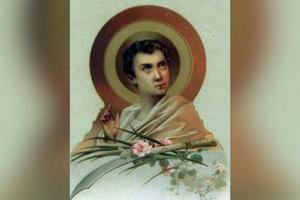St. Cornelius, Pope and Martyr, Pray For Us
SAINTS & ART: Pope St. Cornelius reminded the early Church that God’s mercy can forgive even the worst sins.

First, let’s make sure about whom we’re speaking. The Church today celebrates the feast of Sts. Cornelius and Cyprian. Cornelius was the 21st pope. (For comparison, Francis is 266th). St. Cornelius was pope for about two and a half years, from AD 251-53. We are not discussing Cornelius, the Roman centurion convert to Christianity, whose story appears in Acts 10.
What should we remember about Pope St. Cornelius today? That God’s mercy can forgive even the worst sins.
Cornelius came to the papacy at a very unfortuitous moment in Church history. His predecessor, Fabian, died a martyr. So would he.
Fabian reigned while Decius was Roman Emperor. Decius demanded all subjects of the Empire demonstrate their loyalty to the state by offering sacrifices according to pagan rituals in the public view of Roman officials for the welfare of the state. Those who refused to do so were declared traitors and persecuted. Pope Fabian was one such “traitor” and died.
Persecution was so intense that the Holy See was vacant almost 14 months before a new pope could be chosen. That pope was Cornelius.
The question of God’s forgiveness and mercy enters the picture in conjunction with the Decian persecution. Many Christians remained steadfast in their faith, refused to obey the government’s mandate, and paid the price for it. Some buckled: “Okay, I sacrifice a bull and cross my fingers. That isn’t so bad, is it? God will understand ….”
The Decian persecution was short-lived but intense. When it was over, the question was: what does the Church do with those who buckled, the lapsi (lapsed)?
Remember, while other Christians were denying for their faith, the lapsi were acting like Peter: “Jesus? Never heard of him.” And they were not just doing this in private or in some official’s courtyard. To comply with Decius’s decree, they had to offer their sacrifices according to pagan norms in public before public officials who gave them an official certificate of compliance. Their rejection of their faith was public and on the record.
The Church has always had the power to forgive sins: Jesus gave his Apostles that mission on Easter Sunday night (John 20:21-23). Forgiveness of sins always involved their acknowledgement before the Church (confession) — one cannot be forgiven of what one does not avow — as well as sorrow for sin (contrition) and satisfaction (penance).
But, in the ancient Church, people took their conversion and commitment much more seriously. Baptism was supposed to mark one’s definitive change of life, a change of life that excluded serious sin. Three serious sins were especially singled out for their gravity: murder, adultery and apostasy. Apostasy was denial of one’s faith — what the lapsi did during the Decian persecution.
In Patristic times, serious sins like these demanded public penance. The penitent confessed his sins, received a long penance and was excluded from Communion. That’s why the “Liturgy of the Word” and “Liturgy of the Eucharist” are distinct — the unbaptized and the penitents were dismissed after the sermon. Once a penitent completed that public penance, formally absolved by the bishop on Holy Thursday morning.
When Cornelius became pope, the question of what to do with the lapsi came to the forefront. There were two camps. St. Cyprian, a North African bishop (the Decian persecution had also been intense in places we today call Libya, Tunisia and Algeria) whose feast we also mark today, held that they could be restored to communion with the Church after appropriate penance.
Novatian, who also made himself antipope, led the camp that insisted there was no forgiveness possible for the apostates. Novatian was willing to impose lifelong penance on the apostates, but he fell into heresy when he claimed that the Church lacked the power to absolve the sin of apostasy. How the Church should deal with apostates was one thing; that the Church could not was another. Eventually, his rigorism died out.
The new Roman Emperor, Trebonianus Gallus, launched a new persecution in 252, just nine months after Cornelius came to the papal chair. This time, there were no lapsi. But the Romans exiled Cornelius to what is today Civitavecchia, a port city about 45 miles northwest of Rome. There he died in 253 from the extreme rigors of the exile, though some claim he was beheaded.
Today’s saint is depicted in an oil painting from around 1535-40 by the “Master of Messkirch.” We don’t his name, but his fame has remained primarily because of the 11 paintings he painted for side altars at St. Martin’s Church in Messkirch, Germany, a town in the Baden-Württemberg region of southwest Germany, about 40 miles from the Swiss border.
The painting is simple. Cornelius stands in papal regalia, including the papal tiara, emphasizing his papal legitimacy (a not unimportant factor in Germany 20 years after Martin Luther began his schism). He holds the palm of a victorious martyr. The banner below him reads “Saint Cornelius, Pope and Martyr.” He holds a sword, perhaps alluding to the tradition he was beheaded.
The Master of Messkirch was an example of Renaissance painting, but he’s also considered to have gone into “Mannerism.” Mannerism sought to introduce certain rules into painting that imposed a kind of artificiality on art, one that generally resulted in strangely elongated body proportions. So was St. Cornelius really just a tall guy, or was the Master of Messkirch stretching the reality so as not to bend the artistic rules?
- Keywords:
- st. cornelius
- martyrs
- popes
- saints & art

















